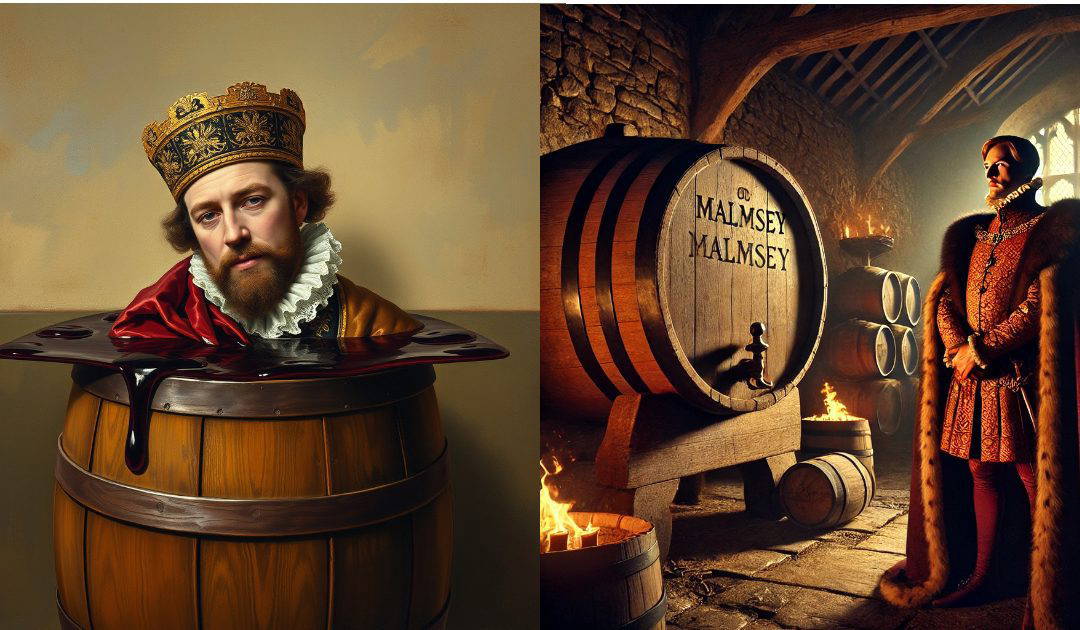On 18th of February 1478, George, Duke of Clarence was executed. He was the brother of King Edward IV. It is said that to avoid bloodshed he was drowned in a vat of malmsey wine, supposedly George’s favourite tipple.
George, Duke of Clarence (1449 – 1478), was a prominent and controversial figure in England’s Wars of the Roses. As the brother of two English kings, Edward IV and Richard III, he played a tumultuous role in the power struggles of the 15th century. His shifting loyalties, ambition, and ultimate downfall led to one of the most infamous executions in English history, allegedly drowning in a vat of malmsey wine.
George Plantagenet was born on October 21, 1449, in Dublin, Ireland, as the third surviving son of Richard, Duke of York, and Cecily Neville. His father was a key claimant to the English throne, challenging the weak rule of King Henry VI of the House of Lancaster. This dispute escalated into the Wars of the Roses (1455 – 1487), a prolonged conflict between the rival House of York (symbolized by a white rose) and the House of Lancaster (symbolised by a red rose).
As a child, George witnessed the violent struggles that plagued his family. His father and elder brother Edmund, Earl of Rutland, were killed at the Battle of Wakefield in 1460, but his older brother Edward successfully led the Yorkist faction to victory, becoming King Edward IV in 1461. In recognition of George’s royal status, he was made Duke of Clarence at the age of 11 and was later knighted.
Despite his privileged position, George was highly ambitious and deeply envious of his brother’s authority. His resentment intensified when Edward IV secretly married Elizabeth Woodville, a commoner and widow, in 1464. The marriage created tensions within the Yorkist court, as the Woodville family gained considerable influence. George aligned himself with the powerful noble Richard Neville, Earl of Warwick (known as the “Kingmaker”), who also opposed the Woodvilles.
In 1469, George married Isabel Neville, Warwick’s daughter, without Edward IV’s approval. This strengthened his bond with Warwick, who soon rebelled against the king. George actively participated in the uprising, which led to Edward IV’s brief deposition in 1470. Warwick restored Henry VI, the Lancastrian king, to the throne, while Edward fled into exile. However, George’s ambition soon clashed with Warwick’s interests, especially when Warwick allied with Margaret of Anjou, Henry VI’s queen.
Realising he would not gain the crown through Warwick’s plans, George switched sides again in 1471, rejoining Edward IV. This betrayal helped Edward reclaim his throne, and Warwick was killed at the Battle of Barnet. George was forgiven and reinstated at court, but his loyalty remained questionable.
Despite his restoration, George’s greed and erratic behavior alienated him from Edward IV. He quarreled with the king over inheritance disputes, particularly after the death of his wife Isabel Neville in 1476. He accused Edward’s queen, Elizabeth Woodville, of plotting against him, leading to further conflicts.
In 1477, George’s rivalry with the king reached its peak when he was implicated in treasonous activities. He reportedly plotted against Edward IV and spread rumors questioning the legitimacy of the king’s children. His reckless actions prompted Edward to arrest him in 1477, and he was imprisoned in the Tower of London.
In February 1478, George was convicted of treason and sentenced to death. His execution method became legendary because he was allegedly drowned in a vat of malmsey wine. While this claim may be exaggerated, it symbolizes his notorious downfall. Malmsey is the sweetest wine variety from Madeira.
Sometimes ChatGBT produces excellent illustrations, whilst sometimes it struggles. Today’s is no better than yesterday’s.

